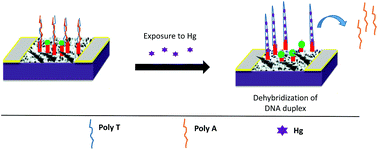An oligonucleotide-functionalized carbon nanotube chemiresistor for sensitive detection of mercury in saliva†
Abstract
Divalent mercuric (Hg2+) ion and monomethyl mercury (CH3Hg+) are two forms of mercury that are known to be highly toxic to humans. In this work, we present a highly selective, sensitive and label-free chemiresistive biosensor for the detection of both, Hg2+ and CH3Hg+ ions using DNA-functionalized single-walled carbon nanotubes (SWNTs). The SWNTs were functionalized with the capture oligonucleotide, polyT, using a linker molecule. The polyT was hybridized with polyA to form a polyT:polyA duplex. Upon exposure to mercury ions, the polyT:polyA duplex dehybridizes and a T–Hg2+–T duplex is formed. This structure switch leads to the release of polyA from the SWNT surface and correspondingly a change in the resistance of the chemiresistive biosensor is observed, which is used to quantify the mercury ion concentration. The biosensor showed a wide dynamic range of 0.5 to 100 nM for the detection of CH3Hg+ ions in buffer solution with a sensitivity of 28.34% per log (nM) of CH3Hg+. Finally, real world application of the biosensor was demonstrated by the detection of Hg2+ and CH3Hg+ ions in simulated saliva samples spiked with a known concentration of mercury ions.

- This article is part of the themed collection: Carbon and graphene in analytical science

 Please wait while we load your content...
Please wait while we load your content...